Unit2Robot教学设计
unit2《robot》全套教案(牛津英语初三下)doc初中英语
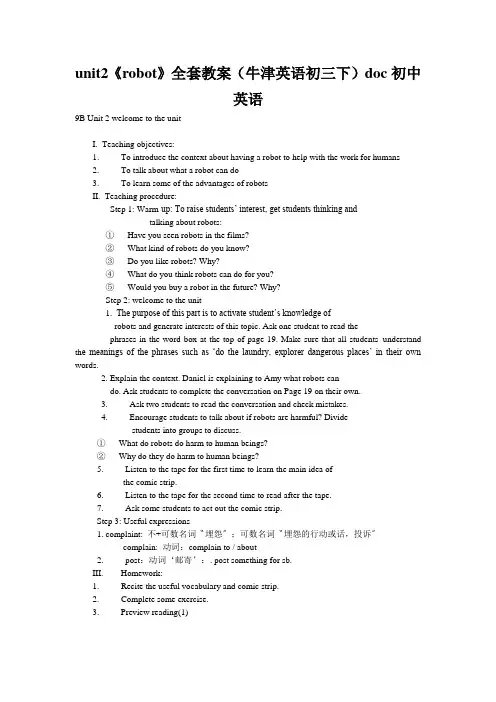
unit2《robot》全套教案(牛津英语初三下)doc初中英语9B Unit 2 welcome to the unitI. Teaching objectives:1. To introduce the context about having a robot to help with the work for humans2. To talk about what a robot can do3. To learn some of the advantages of robotsII. Teaching procedure:Step 1: Warm-up: To raise students’ interest, get students thinking andtalking about robots:① Have you seen robots in the films?② What kind of robots do you know?③ Do you like robots? Why?④ What do you think robots can do for you?⑤ Would you buy a robot in the future? Why?Step 2: welcome to the unit1. The purpose of this part is to activate student’s knowledge ofrobots and generate interests of this topic. Ask one student to read thephrases in the word box at the top of page 19. Make sure that all students understand th e meanings of the phrases such as ‘do the laundry, explorer dangerous places’ in their own words.2. Explain the context. Daniel is explaining to Amy what robots cando. Ask students to complete the conversation on Page 19 on their own.3. Ask two students to read the conversation and check mistakes.4. Encourage students to talk about if robots are harmful? Dividestudents into groups to discuss.① What do robots do harm to human beings?② Why do they do harm to human beings?5. Listen to the tape for the first time to learn the main idea ofthe comic strip.6. Listen to the tape for the second time to read after the tape.7. Ask some students to act out the comic strip.Step 3: Useful expressions1. complaint: 不+可数名词〝埋怨〞;可数名词〝埋怨的行动或话,投诉〞complain: 动词:complain to / about2. post:动词‘邮寄’:. post something for sb.III. Homework:1. Recite the useful vocabulary and comic strip.2. Complete some exercise.3. Preview reading(1)教学小结:学生差不多能把握对话,明白得机器人能为人类做好多事。
高中英语-Unit-2-Robots教案
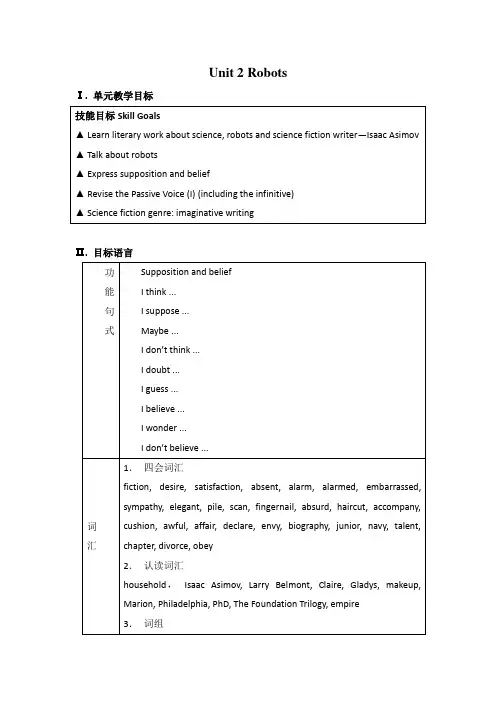
Unit 2 Robots Ⅰ. 单元教学目标Ⅱ. 目标语言Ⅲ. 教材分析和教材重组1. 教材分析本单元以机器人和科幻小说为话题,介绍了20世纪世界知名的科幻小说家Isaac Asimov写于1951的Satisfaction Guaranteed 和作者的生平。
通过本单元的教学,旨在让学生了解科幻小说最大的特征在于:它赋予了“幻想”依靠科技在未来得以实现的极大可能,甚至有些“科学幻想”在多年以后,的确在科学上成为了现实。
如Isaac Asimov1951年描述的机器人的部分功能已经被应用于现实生活和工作中。
在教学中,要鼓励学生敢于幻想,大胆创新,发挥自己丰富的想象力和创作力,写出独具特色的科幻文章。
1.1 Warming Up介绍了什么是机器人和不同种类及不同形状的机器人。
1.2 Pre-reading 通过讨论机器人是否像人类一样有自己的思维、是否有感情引出Isaac Asimov的科幻小说Satisfaction Guaranteed,为本单元的Reading做好了铺垫。
1.3 Reading的课文是Isaac Asimov写于1951的科幻小说Satisfaction Guaranteed。
文中描述的机器人Tony是一个除去面无表情外,身材高大、相貌英俊、聪明机智的完美男人,仅三周的时间就使女主人坠入爱河。
1.4 Comprehending共有3个练习,练习1是关于克莱尔的情感变化,练习2是关于课文内容的5个问答题,旨在考查学生对课文的理解;练习3要求学生比较机器人Tony在physical, mental两方面与人的异同,与Pre-reading 部分的问题相呼应。
1.5 Learning about Language分为两部分,Discovering useful words and expressions 是本单元词汇练习题;Revising useful structures是本单元语法练习题,通过本单元的学习,要求学生熟练掌握不定式的被动语态。
人教版高中英语选修7《Unit 2 Robots》教案2篇
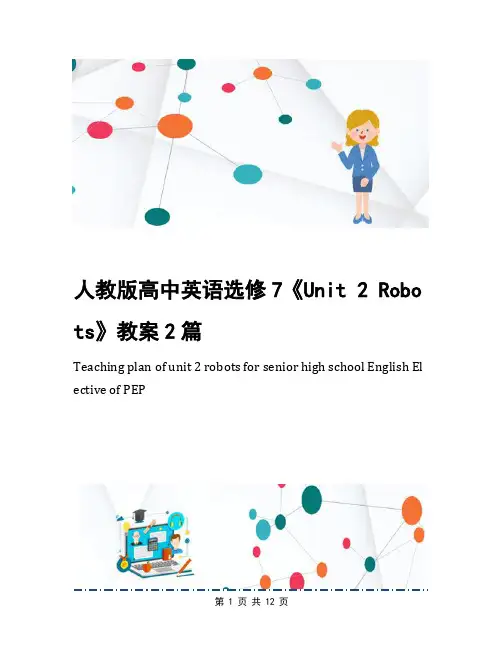
人教版高中英语选修7《Unit 2 Robo ts》教案2篇Teaching plan of unit 2 robots for senior high school English El ective of PEP人教版高中英语选修7《Unit 2 Robots》教案2篇前言:英语作为在许多国际组织或者会议上都是必需语言,几乎所有学校选择英语作为其主要或唯一的外语必修课。
英语教学涉及多种专业理论知识,包括语言学、第二语言习得、词汇学、句法学、文体学、语料库理论、认知心理学等内容。
本教案根据英语课程标准的要求和教学对象的特点,将教学诸要素有序安排,确定合适的教学方案的设想和计划、并以启迪发展学生智力为根本目的。
便于学习和使用,本文档下载后内容可按需编辑修改及打印。
本文简要目录如下:【下载该文档后使用Word打开,按住键盘Ctrl键且鼠标单击目录内容即可跳转到对应篇章】1、篇章1:人教版高中英语选修7《Unit 2 Robots》教案2、篇章2:人教版高中英语选修7《Unit 2 Robots》教案篇章1:人教版高中英语选修7《Unit 2 Robots》教案教学准备教学目标Teaching goals 教学目标1.Be able to learn some important words and phrases2.Help students to learn about robots and science fiction教学重难点eaching important points教学重点Enable students to grasp what Tony did to help Claire and how her emotion developed during Tony’s stay at her house.Teaching dif ficult points 教学难点How Claire’s emotion developed during Tony’s stay at her house.教学过程Teaching procedures 教学过程Step I Warming upPresent a photo of robots. Then ask students to say something about robot.What is on the blackboard?What is a robot?What can a robot do?Step II Pre-readingAsk students to predict question:If you have a robot, will you fall in love with it ?Introduce the background of the text.Step III ReadingFast reading1.What is the text mainly about?It is mainly about how a household _________ was _________ ________ in a family.2.Find the characters in the storyLarry Belmont: working in a company that makes robotsClaire: Larry’s wife, a housewifeTony: the robotGladys Claffern: a woman that Claire envies3.Tell stu dents that Claire’s feelings towar ds Tony changed as the story developed. Read the story again and then fill in the blanks.Comprehensio nRead the sto ry again and find out Claire’s sense of failure and what helps did Tony offer to her.SummaryFill in the blanks according to the knowledge that we have learnt in this class.The company for which Larry worked was to have a newly?made robot____(call)Tony experimented with by his wife Claire at home. At _____first sight of Tony, Claire felt ________(alarm). She thought it was absurd tha t a robot seemed more like a human than a ______ .For as long as three weeks, Tony wanted tohelp her to dress, which made Claire ________(embarrass) and she refused him. But she was glad that Ton y could make her home ________, give her a new h aircut and change her makeup. To improve her home,he could also ________ a list of items for her to buy. And finally Tony helped Claire win the victory to be ________ (envy)by those ladies like Gladys Claffern who Claire wanted to be like. ________made us unbelievable was that Claire fell in love ______Tony—a robot !课后习题Homework1.Surf the Internet to get more information about science fiction..2.Preview the language points in the text.篇章2:人教版高中英语选修7《Unit 2 Robots》教案【按住Ctrl键点此返回目录】教学准备教学目标教学目标1.语言知识: 使学生理解文章中表达情感变化词汇;熟悉有关机器人方面的话题。
牛津译林英语九年级下Unit 2 Robots教案

Unit 2 RobotTeaching objectives:1. To use “in order to” to introduce the purpose of an action.2. To use “as a result” to introduce the result of something.3. to use “need to” to talk about something we have to do.Teaching procedure:Part one: “in order to/as a result”Step 1:PresentationList the two sentences in the reading passage:① In order to have more free time, I have to buy a robot.② As a result, Mr. Jiang no longer needed to get up early to do thehousework.Step 2:PresentationAsk st udents a question: “What should we do if we want to have more free time?” Writesome of the answers on the blackboard and connect them with “in order to”.Step 3: PresentationExplain t students that “in order to” means “with the purpose of “and that w e can use it to introduce the purpose of an action. It can be used at the beginning or in the middle of the sentences.Step 4: Presentation Same method can be applied to introduce “as a result”. Remind students that we use it to introduce the result of something.Step 5: ExerciseAsk students to read the grammar rules and example sentences at the top of page 26 to the class.Step 6:Exercise Asks students to complete the exercise and check the answers as a whole class. Part two: “need to”Step 7: PresentationExplain to students that “need to” is a strong verb. We use it when we want to talk about something we should do.Step 8: PractiseAsk students what things they need to do today. “ I need to …”Step 9: PractiseAsk students to work on their own to complete the exercise using “need to” and the phrases in the box. Check answers with the class.Step 10:ConclutionAsk students to co mplete “work out the rule”.Homework:1. Review grammar 2 and complete exercises.2. Preview “Integrated skills”。
Unit 2 Robots 教学设计1-公开课-优质课(人教选修7精品)
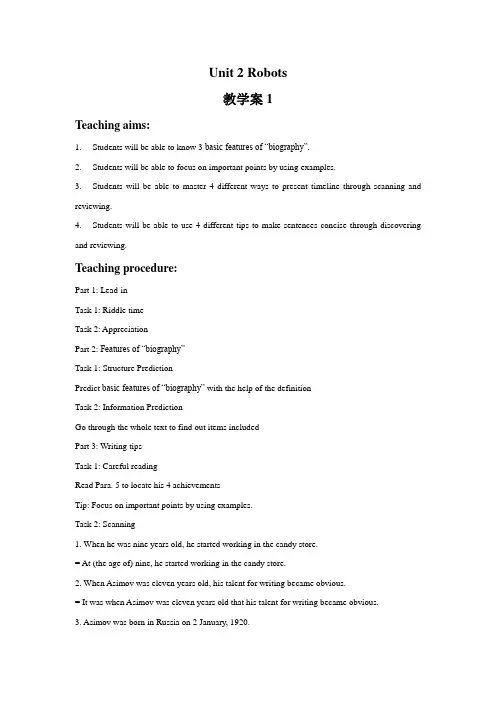
Unit 2 Robots教学案1Teaching aims:1. Students will be able to know 3 basic features of “biography”.2. Students will be able to focus on important points by using examples.3. Students will be able to master 4 different ways to present timeline through scanning and reviewing.4. Students will be able to use 4 different tips to make sentences concise through discovering and reviewing.Teaching procedure:Part 1: Lead-inTask 1: Riddle timeTask 2: AppreciationPart 2: Features of “biography”Task 1: Structure PredictionPredict basic features of “biography” with the help of the definitionTask 2: Information PredictionGo through the whole text to find out items includedPart 3: Writing tipsTask 1: Careful readingRead Para. 5 to locate his 4 achievementsTip: Focus on important points by using examples.Task 2: Scanning1. When he was nine years old, he started working in the candy store.= At (the age of) nine, he started working in the candy store.2. When Asimov was eleven years old, his talent for writing became obvious.= It was when Asimov was eleven years old that his talent for writing became obvious.3. Asimov was born in Russia on 2 January, 1920.= Asimov's life began in Russia, where he was born on 2 January, 1920.4. In the last 30 years, the greatest number of law has stopped our rights and progress= The last 30 years have ____________ the greatest number of laws stopping our rights and progress.Task 3: Learn to use “witness”In 1950 Asimov developed a set of three “laws” for robots.1950 witnessed Asimov (’s) developing a set of three “laws” for robots.Task 4: Discovering and Reviewing1. Asimov had an extraordinary imagination that gave him the ability to explore future worlds and an amazing mind with which he searched for explanations of everything.2. In 1950 Asimov published his first novel and in 1953 he published his first science book.= In 1950 Asimov published his first novel and in 1953 his first science book.3. Because farmers are using his hybrid rice, they are producing harvests twice as large as before. = ___________________, farmers are producing harvests twice as large as before. (M4 U2 Page 9 Working the land)4. Because I was worried about the journey, I was unsettled for the first few days.= _______________________, I was unsettled for the first few days. (M5 U3 Page 17 Life in the future)TIPS: “clause”; Cross repeated words”; “-ing” form; “-ed” form”Part 4: WritingA Short Biography of Wu ShaozeMarch, 12, 1981: born2004: started to work as a math teacher2014: won the award “My Favorite Teacher” of Class 7 Grade 2(attitude; talent; character; knowledge; … )Homework:1. Finish your writing and polish it.2. Read and learn from passages about persons in the textbook.。
高中英语 Unit 2 Robots教案
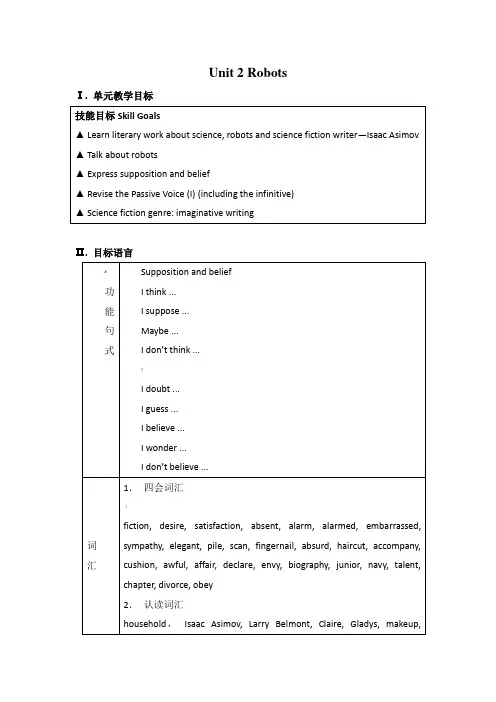
Unit 2 Robots Ⅰ. 单元教学目标Ⅱ. 目标语言…Ⅲ. 教材分析和教材重组1. 教材分析本单元以机器人和科幻小说为话题,介绍了20世纪世界知名的科幻小说家Isaac Asimov写于1951的Satisfaction Guaranteed 和作者的生平。
通过本单元的教学,旨在让学生了解科幻小说最大的特征在于:它赋予了“幻想”依靠科技在未来得以实现的极大可能,甚至有些“科学幻想”在多年以后,的确在科学上成为了现实。
如Isaac Asimov1951年描述的机器人的部分功能已经被应用于现实生活和工作中。
在教学中,要鼓励学生敢于幻想,大胆创新,发挥自己丰富的想象力和创作力,写出独具特色的科幻文章。
Warming Up介绍了什么是机器人和不同种类及不同形状的机器人。
Pre-reading 通过讨论机器人是否像人类一样有自己的思维、是否有感情引出Isaac Asimov的科幻小说Satisfaction Guaranteed,为本单元的Reading做好了铺垫。
Reading的课文是Isaac Asimov写于1951的科幻小说Satisfaction Guaranteed。
文中描述的机器人Tony是一个除去面无表情外,身材高大、相貌英俊、聪明机智的完美男人,仅三周的时间就使女主人坠入爱河。
Comprehending共有3个练习,练习1是关于克莱尔的情感变化,练习2是关于课文内容的5个问答题,旨在考查学生对课文的理解;练习3要求学生比较机器人Tony在physical, mental两方面与人的异同,与Pre-reading 部分的问题相呼应。
Learning about Language分为两部分,Discovering useful words and expressions 是本单元词汇练习题;Revising useful structures是本单元语法练习题,通过本单元的学习,要求学生熟练掌握不定式的被动语态。
英语:unit2《robots》教案(2)(新人教版选修7).doc
Do Exx.4 & 5 on P15.
小组针对话题进行讨论。
小组进行讨论,运用所学内容。
第
28-39分钟
完成任务
Task of Unit 2:The Future Robot Company in America is holding a robot design competition. Design your robot and write a design plan.
What trouble does Tony cause?
Molly and Kate are also discussing the storySATISFACTION GUARANTEED.
Can you guess which topic they will discuss?
讨论,分析Tony带来的负面效果。
预测课文内容。
通过预测,激发学生的学习兴趣。
第
6-21
分钟
读中任务
While-reading task
1. Reading, discussing & writing, P16
2. Read the passage and find out the main idea of the passage.
Please make a list of the troubles that might be caused by robots and give your reasons.
想象机器人带来的负面效应,为进一步学习做准备。
激发学生的学习兴趣。
第
4
分钟
呈现任务
Task of Unit 2:The Future Robot Company in America is holding a robot design competition. Design your robot and write a design plan.
unit2《robot》教案(牛津英语初三下)doc初中英语
unit2《robot》教案(牛津英语初三下)doc初中英语VocabularyTeaching objectives:1. To learn the names of different parts of a robot.2. To design an ideal robot3. To write an article to describe the ideal robot.Teaching procedure:Step 1:In weaker classes, students probably will not know what some of the words in Part A mean. Write the words on the blackboard and help them finish the part. e.g.: What’s the use of a camera/battery/hand/wheel/speaker?A camera takes pictures.A battery gives us power.A hand helps pick up things.Wheels help things move.We can hear sound through a speaker.Step 2:Show students robot pictures and ask students what other features a robot might have. This will help students with Part B. Encourage students to use their imagination.① Ask students to look at the picture on page 24 and answer the questions.② Ask students questions according to the pictures shown:What does it look like?What is there on the head/in the face/on both sides of its body?How does it speak?What is the use of the arms/hands?How does it move?What kind of energy does it have?Step 3: Explain the context of part b. Daniel is writing an article to describe his ideal robot. Have students work in pairs and complete theexercise.Step 4:Ask volunteers to read the completed article for the class. Check for mistakes and mispronunciations.Homework:1. Preview Grammar 12. complete some exercises.。
高中英语人教版Unit2Robots 教学设计
教学设计Teaching aims:the students’ reading and speaking ability.some useful words,expressions and some important sentences.the students to sum up the main idea and make a summary of the passagetheir opinions by answering and arguing the questions.their awareness of studying hard and loving scienceTeaching Methods:Explaining, reading and practising, pair work and group argumentTeaching Aids:A multimedia and reward cards .Teaching Procedures:I、Pre-review before class(课前预习)Preview the words and phrases of U2( part one )II、Group work in class(课内探究)Step1:Leading in:Task 1:you like to see a robot dace ? Now let’s enjoy the videoWho are dancing ?__________________________________________________________________What is a robot ?_____________________________________________________________________[设计说明]利用视频导入,把机器人这个主题更直观的展示给学生,激发学生的兴趣和求知欲,提高课堂效率。
Unit2Robots任务型教学设计
Unit 2 Robots任务型教学设计第一课时一、教学内容分析教学内容《英语》(人教版)选修7 Unit 2 Robots 第一课时教学对象高二学生教学项目词语 industrial military vacuum helicopter结构课文Listening & Speaking教学目标语言知识熟悉有关机器人种类与功能的话题。
语言技能能运用词汇表述自己的想法与观点。
语言运用能运用语言就选择什么样的机器人发表自己的观点。
文化意识培养学生想象力和对未知世界的探索精神。
情感态度在英语学习中有较强的自信心,敢于用英语进行交流与表达。
学习策略借助联想学习相关词汇。
教学方法任务教学法、学生中心教学法、多媒体教学法教学媒体 PPT幻灯媒体、黑板教学重点学习有关机器人的词汇,培养学生表达能力。
教学难点培养学生的表达及判断能力。
运用任务 Task of Unit 2: The Future Robot Company in America is holding a robot design compe tition. Design your robot and write a design plan.Task of Period 1: Make a list of different kinds of robots and their functions and decide wh at kind of robots you want to design.二、课堂教学过程时间教学步骤教师活动学生活动教学目的第1-5分钟热身导入,启动教学播放有关奥特曼的动画片段:1. Can you make a list of works which include robots as characters? (Choose one and get prep ared to tell the class about it briefly.)2. What is a robot in your opinion?(A robot is a machine designed to do jobs that are usually performed by humans.Robots are pr ogrammed and controlled by a computer.) 思考有关机器人的作品。
- 1、下载文档前请自行甄别文档内容的完整性,平台不提供额外的编辑、内容补充、找答案等附加服务。
- 2、"仅部分预览"的文档,不可在线预览部分如存在完整性等问题,可反馈申请退款(可完整预览的文档不适用该条件!)。
- 3、如文档侵犯您的权益,请联系客服反馈,我们会尽快为您处理(人工客服工作时间:9:00-18:30)。
Unit2Robot教学设计Unit2robot teaching design
Unit2Robot教学设计
前言:小泰温馨提醒,英语作为在许多国际组织或者会议上都是必需语言,几乎所有学校
选择英语作为其主要或唯一的外语必修课。
英语教学涉及多种专业理论知识,包括语言学、第二语言习得、词汇学、句法学、文体学、语料库理论、认知心理学等内容。
本教案根据
英语课程标准的要求和针对教学对象是初中生群体的特点,将教学诸要素有序安排,确定
合适的教学方案的设想和计划、并以启迪发展学生智力为根本目的。
便于学习和使用,本
文下载后内容可随意修改调整及打印。
一、基础词汇
(n.)
1.洗衣服的活
2.推销员
3.定单
4.病毒
5.垃圾箱
6.混乱
7.洗涤槽
8.垃圾、废物
9.中午
10.电池
11.轮子、车轮
12.胸膛
(v.)
1.邮寄
2.熨烫
3.打扫、清扫
4.展开,扩散
5.倒空、腾空
(adj.)
1 脏的
2.每日的___________
3.干的____________
(adv.)
自由地
二、重点词组
1.第一个做……的人
2.改变了许
多 _____
3.为了有更多的空闲时间
4.熨烫衬衫 _____
5.结果
6.不
再 _____
7.睡在床上
8.再多一小
9.洗衣服
10.洗盘
子 _____
11.扫地
12.铺
床 ____
13.下班回家
14.对……满
意 ___
15.准备
16.出
错 ____
17.感染病毒
18.制造许多麻烦 _____
19.唤醒
20.把东西撞翻 _____
21.发现房间一团糟
22.对
付 _____
23.最后
24.太多的麻
三、句型结构
1.mr jiang is the first person in sunshine town to own a robot.
(the first/second/last…to do)
1)妇女和孩子们是第一个进入救生船的。
women and
children
the lifeboats
2)张老师总是最后一个离开学校。
mr
zhang always
school.
2.the robot was just too much trouble.
注意:too much, much too, too many的含义及用法。
1)超市里太拥挤了,有很多便宜的衣服。
the supermarket
is crowded. there
are cheap clothes.
2)李雷上学迟到了,马路上车辆太多。
li lei was late for school because there
was traffic.
3.when mr jiang returned home from work, his flat would be as clean as new.
注意:return不能和back同时使用。
1)妈妈下班回家的时候,我正在做作业。
when mum home from work, i was doing my homework.
when mum home from work, i was doing my homework.
2)李老师已经把书还给图书馆了。
miss li the book to the library.
miss li the book to the library.
4.mr jiang did not know what he should do with the robot.
mr jiang did not know __________ __________
_________ ____________ the robot.
do with 和 deal with
他不知道怎样处理他的旧自行车。
he didn’t know __________ _______ _____________
__________ his old bike.
他们学会了如何处理各种问题。
they learned ___________ ______ _____________
___________ any sort of problem.
四、难点语法
1.运用wh--特殊疑问词引导的宾语从句
注意:
1)时态一致;2)陈述句的语序
将下列句子合并为含有宾语从句的主从复合句。
1)where did mr jiang buy the robot? i’d like to know.
i’d like to
know
.
2)what’s wrong with the robot? i didn’t know.
i didn’t
know
.
3) how does the robot wash the dishes? i wonder.
i
wonder
.
2.in order to和as a result分别表示“目的”和“结果”
3.用need来谈论我们不得不做的事情。
总结need的几种用法.
need to do ; need do; need doing =need to be done
1)为了提高我的英语成绩,我需要买一本电子词典。
_____ improve my english,
i ________an e-dictionary.
2)我的电脑坏了。
它需要修理。
there is something wrong with my computer.
it ________.
3)机器人帮江先生做了很多家务。
因此,他不需要早起。
the robot helped mr jiang do lots of
housework. ____________ ___, he
________ _______early.
-------- Designed By JinTai College ---------。
